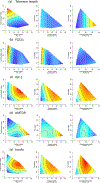Does diet influence aging? Evidence from animal studies
- PMID: 35701180
- PMCID: PMC12023453
- DOI: 10.1111/joim.13530
Does diet influence aging? Evidence from animal studies
Abstract
Nutrition profoundly influences the risk for many age-related diseases. Whether nutrition influences human aging biology directly is less clear. Studies in different animal species indicate that reducing food intake ("caloric restriction" [CR]) can increase lifespan and delay the onset of diseases and the biological hallmarks of aging. Obesity has been described as "accelerated aging" and therefore the lifespan and health benefits generated by CR in both aging and obesity may occur via similar mechanisms. Beyond calorie intake, studies based on nutritional geometry have shown that protein intake and the interaction between dietary protein and carbohydrates influence age-related health and lifespan. Studies where animals are calorically restricted by providing free access to diluted diets have had less impact on lifespan than those studies where animals are given a reduced aliquot of food each day and are fasting between meals. This has drawn attention to the role of fasting in health and aging, and exploration of the health effects of various fasting regimes. Although definitive human clinical trials of nutrition and aging would need to be unfeasibly long and unrealistically controlled, there is good evidence from animal experiments that some nutritional interventions based on CR, manipulating dietary macronutrients, and fasting can influence aging biology and lifespan.
Keywords: aging; caloric restriction; fasting; nutritional geometry; obesity.
© 2022 The Authors. Journal of Internal Medicine published by John Wiley & Sons Ltd on behalf of Association for Publication of The Journal of Internal Medicine.
Conflict of interest statement
Conflict of interest
There is no conflict of interest to declare.
Figures



References
-
- World Health Organization. Decade of healthy ageing 2020–2030. https://cdn.who.int/media/docs/default-source/decade-of-healthy-ageing/f... (2020). Accessed June 21, 2022.
-
- Everitt AV, Rattan SI, Le Couteur DG, de Cabo R. Calorie restriction, aging and longevity. New York: Springer Press; 2010.
Publication types
MeSH terms
Grants and funding
LinkOut - more resources
Full Text Sources
Medical

